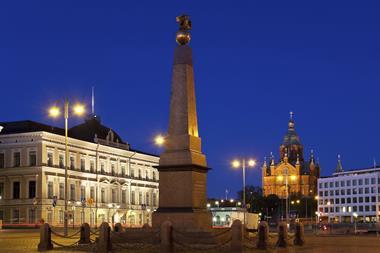The picture for Irish property looks set to improve in tandem with the wider economy. Growth forecasts for the Irish economy have increased significantly over recent months with the latest economic data suggesting a strong recovery in economic conditions. GDP growth of 4.5% is now anticipated for 2004, with 5% plus projected for 2005 by several prominent economic commentators.
The key driver and risk to this outlook will be the continued momentum in global economic growth, particularly in the US. Foreign direct investment has been a key ingredient in Ireland’s economic success. Interest rates are also a major influence on our economic prospects. While we are likely to see some upward pressure on euro interest rates this will be at a level to encourage the sluggish pace of growth across wider Euro-zone and, if history repeats itself, will be a stimulus to higher growth economies like Ireland. Inflation is an obvious concern, and while this has reduced significantly over the last 12 months, competitiveness will continue to be a serious challenge for the economy.
While the forecast level of economic growth would not represent a repeat of the full Celtic Tiger roar heard through the late 1990’s, it is exceptional by most comparisons and provides a healthy environment for generating positive property returns. There has been a very strong correlation between Irish commercial property returns and economic growth. This is clearly demonstrated in figure 1 which tracks the relationship over the course of 28 years, embracing three full property cycles. The improved outlook for the Irish economy augurs well for the property market as one can reasonably expect this close relationship to persist.
In addition to highlighting growth potential the graph also highlights one of the key defensive qualities of Irish commercial property. Negative returns have only been seen on a few occasions and to a very limited extent each time. In fact on a three year rolling basis nominal returns remain positive throughout this long timescale. Key to this has been the robust income return, which runs at 6-7% annually and is supported by the long duration of leases, typically 15-25 years, and five yearly upward only rent reviews.
The Irish commercial property market has continued to generate solid returns through 2004, with the retail sector leading the way (see figure 2). The SCS/IPD Irish Index measured the total return of the Irish market at 2% for the first quarter of 2004, 2.3% for the second quarter and 2.4% for the third quarter. This brings the return for the 12 months to September 2004 to about 11%, made up of about 5% income return plus 6% capital growth. It is estimated that across the three sectors - retail, industrial and offices - total returns for the first nine months of 2004 have been about 10, 6 and 5% respectively, bringing the 2004 market return to about 7.5% in the first three quarters. The main drivers of capital growth continue to be retail rental growth, allied to yield compression resulting from strong investor demand.
Strong consumer spending and low interest rates have fuelled the strength of the retail market. Prime retail rents have been driven by demand from retailers, led by UK and European multiples such as Monsoon and Zara, coupled with a limited supply of prime shops. The lack of opportunities in the prime shopping streets has had a positive impact on demand for units in well-located shopping centres. The most recent example is the letting to H&M at the ILAC centre in Dublin. This has had a strong positive impact on retail rental growth, which has been running at close to 10% through 2003 and 2004, although this is likely to reduce to lower more sustainable rates through the remainder of this year and next.
The office and industrial sectors continue to suffer from high vacancy rates. This year, there has been a pick up in office tenant inquiries, which is starting to translate to actual take up. This improvement has been primarily based in the city centre, with a significant level of activity focused on the south quays area, which is developing as an extension to the prime D2 city office core. A number of key deals are close to being signed with further significant deals currently under active negotiation. However, headline rents continue to be masked by incentives such as rent-free periods however the value of these are reducing. Boosted by a pick up in letting activity, the overall vacancy rate in the Dublin office market has declined slightly to 16?%. The city centre vacancy rate at 8.5% is within sight of the equilibrium level of 7%, where the market will start to see a pick up in rents.
Suburban office markets, which had been the focus of new development through the last cycle, continue to labour under the weight of high vacancies. New supply has now diminished in these locations and, in a growing number of cases sites with existing office planning permissions are now seeing proposed alternative uses, primarily to residential. Sandyford, a south city suburban location, is a case in point, where the opening of the LUAS tram line is set to impact residential land values and potential office take up.
While the office market has turned the corner the recovery has yet to gain real momentum and strong sustained economic growth will be required for a return to positive rental growth from the sector. Through the next cycle location will be particularly important, as the rising tide will not necessarily lift all sub-markets.
Irish investors have not lost their appetite for good quality Irish property investments. The investment market is currently characterised by a lack of opportunities, which has resulted in the most significant deals being forward funded development schemes. Strong investor demand continues to support capital values at a time when one would normally have expected some slippage in values, particularly given the softness of the office and industrial markets. Private investor demand fuelled by the low cost and availability of debt, the re-emergence of institutional demand and a limited supply of investment product, are leading to improving values as yields continue to edge downwards. Prime office yields have contracted to 5.25%, while prime industrial yields have stabilised at 6.5% and prime retail at 3.25%.
Looking forward the improved outlook for the Irish economy augurs well for the prospects for the property fundamentals that drive Irish commercial property returns.
Martin O’Reilly is a senior property fund manager at Irish Life Investment Managers













No comments yet